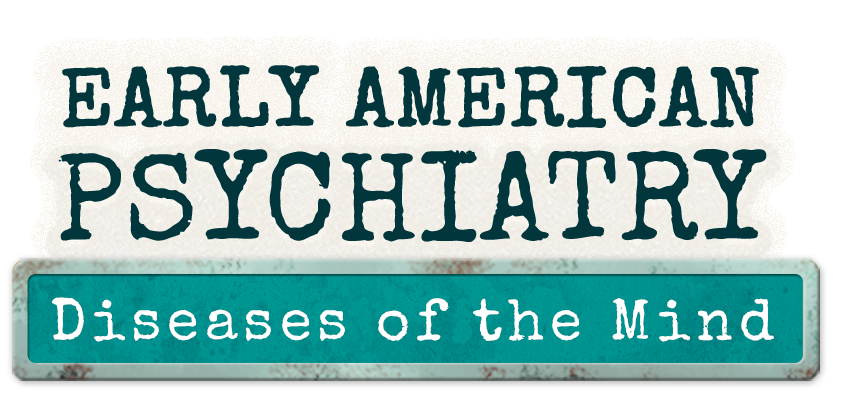Further Reading
Early Psychiatric Hospitals & Asylums
1752
Code of rules and regulations for the government of those employed in the care of the patients of the Pennsylvania Hospital for the Insane, near Philadelphia. (Philadelphia, 1850).
An appeal to the citizens of Pennsylvania for means to provide additional accomodations for the insane. (Philadelphia, 1854).
George B. Wood. Proceedings on the occasion of laying the corner stone of the new Pennsylvania Hospital for the Insane at Philadelphia. (Philadelphia, 1856).
Professionalization: Superintendents Association
John M. Galt. Essays on asylums for persons of unsound mind. (Richmond, 1853). Two essays offered as reports to the Association of Medical Superintendents of American Institutions for the Insane, in 1848 and 1853.
Activism
Dorothea L. Dix. Memorial, to the Legislature of Massachusetts. (Boston, 1843).
Dorothea L. Dix. Memorial of Miss D. L. Dix: to the honorable the General Assembly in behalf of the insane of Maryland. (Annapolis, 1852).
Women in Psychiatry
M. P. Jacobi, The Question of Rest for Women During Menstruation, New York, 1877
Psychiatric Debates
John Bucknill, Notes on Asylums for the Insane in America (London, 1876).
Notable Works
Earle, Pliny. An examination of the practice of bloodletting in mental disorders. New York: Wood, 1854.
Earle, Pliny. The Curability of Insanity. Utica, N.Y.: Ellis H. Roberts & Co., printers, 1877.
Jarvis, Edward. Practical Physiology for the Use of Schools and Families. Philadelphia: Thomas, Cowperthwait, 1848.
Kirkbride, Thomas Story. On the Construction, Organization, and General Arrangements of Hospitals for the Insane. Philadelphia, 1854.
Ray, Isaac. Insanity of King George III: read before the Association of Superintendents of Insane Hospitals, May 22, 1855. Utica, N.Y.: Printed at the Asylum, 1855.
Ray, Isaac. A Treatise on the Medical Jurisprudence of Insanity. Boston: Charles C. Little and James Brown, 1838.
Rush, Benjamin. Medical Inquiries and Observations upon Diseases of the Mind. Philadelphia: Published by Kimber & Richardson ... ; Merritt, printer ..., 1812.
Sachs, Bernard. A Treatise on the Nervous Diseases of Children. New York: Wood, 1895.
Sachs, Bernard, and Louis Hausman. Nervous and Mental Disorders from Birth to Adolescence. New York: Hoeber, 1926.
Tuke, Samuel. Practical Hints on the Construction and Economy of Pauper Lunatic Asylums. London: York, 1815.
NLM Resources
Exhibitions
Care and Custody: Past Responses to Mental Health: Over the past 200 years in the United States, a tension has existed between care and custody as responses to mental health issues. The actions of physicians, psychiatric survivors, families, and government agencies have all shaped mental health policies. Care and Custody: Past Responses to Mental Health examines history to understand how the country has moved away from custodial forms of treatment, sought a more inclusive society, and worked to protect the rights of people with mental health conditions.
Emotions and Disease: How we talk about emotions and disease has changed in the course of history, as scientists and physicians transformed medicine. Perceptive observers have regularly returned to the study of the interactions of body and mind in medicine.
The Literature of Prescription: Charlotte Perkins Gilman and "The Yellow Wall-Paper": During a time when women were challenging traditional ideas about gender that excluded them from political and intellectual life, artist and writer Charlotte Perkins Gilman rejected these ideas in a terrifying short story titled "The Yellow Wall-Paper.” The Literature of Prescription: Charlotte Perkins Gilman and “The Yellow Wall-Paper” explores the story behind Gilman’s indictment of the medical profession and the social conventions restricting women’s professional and creative opportunities.
Graphic Medicine: Ill-Conceived and Well-Drawn!: People have told stories of illness from the perspective of their personal experiences using many mediums. The art of comics, which combines words and pictures, gives approachability and emotional impact to these personal stories, and even to the clinical data they sometimes include. Graphic Medicine: Ill-Conceived and Well-Drawn! explores the meaning of an emerging sub-genre of medical literature that combines the art of comics and the personal illness narrative.
“And there’s the humor of it!”: Shakespeare and the four humors: English poet and playwright William Shakespeare created characters that are among the richest and most humanly recognizable in all of literature. Yet Shakespeare understood human personality and health in the terms available to his age—that of the now-discarded theory of the four bodily humors—blood, yellow bile, black bile, and phlegm. "And there's the humor of it": Shakespeare and the four humors explores the language of the four humors and their influence in Shakespeare’s plays.
Medicine on Screen
Shared Suffering Onscreen: Animal Experiments and Emotional Investment in the Films of O. H. Mowrer By Benjamín Schultz-Figueroa, PhD, Assistant Professor in Film Studies, Seattle University The history of animal testing and the history of the life sciences go hand in hand. Donna Haraway describes the emotional and ethical complexities with this work as the “shared suffering” of the lab. This argument is premised on the recognition of animal agency in the lab, a space where animals, apparatuses, and scientists are all responding and responsible to each other, though in very different ways.
The Cinema of Schizophrenia By Mark S. Micale Schizophrenia was a new diagnosis in interwar American medicine. Invented in 1911 by Swiss psychiatrist Eugen Bleuler (1857–1939), the term gradually supplanted “dementia praecox,” which after World War I was associated too closely with German psychiatry.
Profiles in Science
The Mike Gorman Papers: Thomas Francis Xavier (Mike) Gorman (1913–1989) was a well-known journalist, author, publicist, and crusader for health policy reform. He won a Lasker Award in 1948 for his newspaper exposés of state mental hospital conditions in Oklahoma, and from 1953 to 1989 directed the National Committee Against Mental Illness, a lobbying and advocacy group.
Lawrence Kolb Papers: Psychiatrist Lawrence Kolb (1881-1972) was a career medical officer and administrator in the U. S. Public Health Service, best known for his innovative diagnostic framework for drug addiction and its treatment, and his insistence that drug addiction was a medical problem, not a criminal one.
Circulating Now
Explore blog posts on Mental Health and Psychiatry
Professionalization: Superintendents Association
MedlinePlus Health Topic: Mental Health

